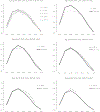Reconstruction of Birth Histories for the Study of Fertility in the United States, 1830-1910
- PMID: 34853487
- PMCID: PMC8631723
- DOI: 10.1080/01615440.2019.1664357
Reconstruction of Birth Histories for the Study of Fertility in the United States, 1830-1910
Abstract
This paper describes a method to reconstruct complete birth histories for women in the 1900 and 1910 U. S. census IPUMS samples. The method is an extension of an earlier method developed by Luther and Cho (1988). The basic method relies on the number of children ever born, number of children surviving, number of children coresident in the household and age-specific fertility rates for the population to probabilistically assign an "age" to deceased and unmatched children. Modifications include the addition of an iterative Poisson regression model to fine-tune age-specific fertility inputs. The potential of complete birth histories for the study of the U.S. fertility transition is illustrated with a few examples.
Figures








Similar articles
-
Assisted reproductive technology surveillance -- United States, 2010.MMWR Surveill Summ. 2013 Dec 6;62(9):1-24. MMWR Surveill Summ. 2013. PMID: 24304902
-
Assisted reproductive technology surveillance--United States, 2011.MMWR Surveill Summ. 2014 Nov 21;63(10):1-28. MMWR Surveill Summ. 2014. PMID: 25412164
-
Household population multiple-condition development equations and their application.Chin J Popul Sci. 1990;2(3):219-27. Chin J Popul Sci. 1990. PMID: 12284986
-
Population policies and reproductive patterns in Vietnam.Lancet. 1996 Jun 1;347(9014):1529-32. doi: 10.1016/s0140-6736(96)90676-5. Lancet. 1996. PMID: 8684107
-
Understanding U.S. fertility: continuity and change in the National Survey of Family Growth, 1988-1995.Fam Plann Perspect. 1996 Jan-Feb;28(1):4-12. Fam Plann Perspect. 1996. PMID: 8822409 Review.
Cited by
-
Early Fertility Decline in the United States: Tests of Alternative Hypotheses using New IPUMS Complete-Count Census Microdata and Enhanced County-Level Data.Res Econ Hist. 2021;37:89-128. Epub 2021 Sep 30. Res Econ Hist. 2021. PMID: 36032065 Free PMC article.
-
The impact of US assimilation and allotment policy on American Indian mortality.Proc Natl Acad Sci U S A. 2025 Jul 15;122(28):e2418836122. doi: 10.1073/pnas.2418836122. Epub 2025 Jul 11. Proc Natl Acad Sci U S A. 2025. PMID: 40643978 Free PMC article.
-
Racial residential segregation and child mortality in the southern United States at the turn of the 20th century.Popul Space Place. 2023 Aug;29(6):e2678. doi: 10.1002/psp.2678. Epub 2023 Jun 7. Popul Space Place. 2023. PMID: 39552937 Free PMC article.
-
The Impact of Multiple Births on Fertility: Stopping and Spacing in the United States During the Demographic Transition.Demography. 2024 Oct 1;61(5):1509-1533. doi: 10.1215/00703370-11577526. Demography. 2024. PMID: 39319997
References
-
- Alter G. 2016. Understanding historical and contemporary fertility transitions: A birth interval approach. Paper presented at the seminar “Linking past to present: Long-term perspectives on micro-level demographic processes,: organized by the IUSSP Scientific Panel on Historical Demography, Reitaku University, Kashiwa, Japan, December 9–11.
-
- Alter G. and Hacker JD 2019. The impact of multiple births on fertility and family support in the early 20th-century. Paper presented at the IUSSP International Seminar on Kinship and Reproduction in Past Societies, Minneapolis, Minnesota, August 23, 2019.
-
- Anderton DL and Bean LL 1985. Birth spacing and fertility limitation: A behavioral analysis of a 19th-century frontier population. Demography 22: 169–183. - PubMed
-
- Bengtsson T. and Dribe M. 2006. Deliberate control in a natural fertility population: Southern Sweden, 1766–1864. Demography 43: 727–746. - PubMed
-
- Brass W. 1960. The graduation of fertility distributions by polynomial functions. Population Studies 14: 148–162.
Grants and funding
LinkOut - more resources
Full Text Sources
